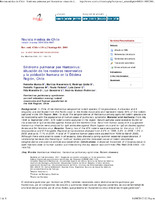Use este identificador para citar ou linkar para este item:
http://sgc.anlis.gob.ar/handle/123456789/370| Título : | Síndrome pulmonar por Hantavirus: situación de los roedores reservorios y la población humana en la Décima Región, Chile | Otros títulos : | Hantavirus pulmonary syndrome: current situation among rodent reservoirs and human population in the Xth Region, Chile | Autor : | Murúa, Roberto Navarrete, Maritza Cadiz, Rodrigo Figueroa, Rodolfo Padula, Paula Zaror, Luis Mansilla, Rita Gonzalez, Luz Munoz-Pedreros, Andrés |
Palabras clave : | Hantavirus;Síndrome Pulmonar por Hantavirus;Enfermedades de los Roedores;Chile | Fecha de publicación : | feb-2003 | Journal: | Revista Medica de Chile | Resumen : | In Chile, three Hantavirus seropositive rodent species (O longicaudatus, A olivaceus and A longipilis) are distributed from the Pacific coast to the Andes mountains and represent nearly 90% of the rodents captured in the Xth Region. Aim: To study the seroprevalence of Hantavirus among captured rodent species and its relationship with the appearance of human cases of pulmonary syndrome. Material and methods: From May 1998 to September 2001, 675 rodents were captured in the region. Serum samples were tested by ELISA for the presence of IgG antibodies against Andes and Sin Nombre virus. Sera from human cases with a suspected Hantavirus infection were analyzed for IgM antibodies against Black Lagoon virus and for IgG antibodies against Andes and Sin Nombre virus. Results: Twenty two of the 675 rodents were seropositive for the virus, 18 O longicaudatus and 4 A longipilis. Regional seroprevalence changed from 2.2% in 1998, 0.0% in 1999, 1.0% in 2000 and up to 7.1% in 2001. A total of 77 positive human cases were studied from 1998 to March 2002. Although there were positive cases in all seasons, data showed a spring-summer seasonal preponderance. A relationship between the flowering of "colihue" bushes and the increased values of rodent abundance, seroprevalence and positive animals was established. Conclusions: A dispersal movement of O longicaudatus to open habitats close to human outdoor activities during the dry season was confirmed. |
Descripción : | Fil: Murúa, Roberto. Universidad Austral de Chile. Instituto de Ecología y Evolución; Chile. Fil: Navarrete, Maritza. Universidad Austral de Chile; Chile. Fil: Cadiz, Rodrigo. Universidad Austral de Chile; Chile. Fil: Padula, Paula. ANLIS Dr.C.G.Malbrán. Instituto Nacional de Enfermedades Infecciosas; Argentina. Fil: Zaror, Luis. Universidad Austral de Chile; Chile. Fil: Munoz-Pedreros, Andrés. Universidad Católica de Temuco.; Chile. Fil: Figueroa, Rodolfo. Universidad Austral de Chile; Chile Fil: Mansilla, Rita. Universidad Austral de Chile. Instituto de Ecología y Evolución; Chile. Fil: Gonzalez, Luz. Universidad Austral de Chile. Instituto de Ecología y Evolución; Chile. |
URI : | http://sgc.anlis.gob.ar/handle/123456789/370 http://www.scielo.cl/scielo.php?pid=S0034-98872003000200006&script=sci_arttext |
ISSN : | 0034-9887 | Derechos: | info:eu-repo/semantics/openAccess |
| Aparece nas Coleções: | snrd Publicaciones INEI |
Arquivos neste item:
| Arquivo | Descrição | Tamanho | Formato | |
|---|---|---|---|---|
| RevistaMedicaDeChile,2003,131(2),169–176..pdf | Artículo en español | 250.79 kB | Adobe PDF |  Visualizar/Abrir |
Visualização de página
146
Checado em 09/01/2026
Download(s)
87
Checado em 09/01/2026
Google ScholarTM
Checar
Os itens no repositório estão protegidos por copyright, com todos os direitos reservados, salvo quando é indicado o contrário.

